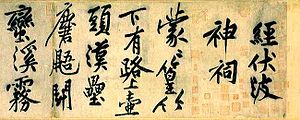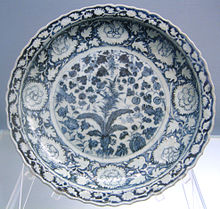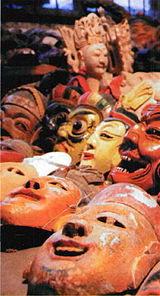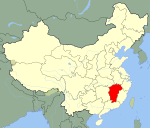- Culture of Jiangxi
-
 Bada Shanren, 1626—1705
Bada Shanren, 1626—1705
The culture of Jiangxi refers to the culture of the people based in Jiangxi. It has changed greatly over several millenniums, from the land's prehistoric period to its contemporary hybrid culture, which originates from Baiyue, inherits Ancient China and is modernly influenced by Western culture.
Geographic situation makes Jiangxi distinguish from its neighbours, as high mountains separate it from Zhejiang to the east, Fujian and Guangdong to the south, Hunan to the west and Yangzi River forms a natural division between the South and northern China.
Contents
Language
Main article: Gan languageThe Gan language has always played a significant role in Jiangxi culture. The language is spoken mainly in Jiangxi but also in surrounding regions such as Hunan, Hubei, Anhui, Fujian, etc. Modern Gan language is considered as one of Sinitic languages, which derives from Old Gan and still keeps some linguistic traces of ancient languages in South China.
The language is written in traditional Chinese characters with Gan variant. Many vocabularies are no longer used in Chinese, especially in Mandarin, while they remain daily words in Gan. For example, cooking utensils are called uoh(鑊) or tiang(鼎) in Gan which date back to Shang Dynasty. The Bible was also translated into some Gan dialects as the Christianity was introduced into Jiangxi as early as the 16th century, with the arrival of Marco Polo.
Literature
Main article: Literature of JiangxiVisual arts
 Huang Tingjian writing
Huang Tingjian writing
Painting
Main article: Painting of JiangxiCalligraphy
Main article: Calligraphy of JiangxiSculpture
Main article: Sculpture of JiangxiPerforming arts
Gan opera
Main article: GanjuCaicha opera
Main article: Tea-picking operaNuo opera
Main article: Nuo operaNuo opera, which is said to have some relations with Baiyue culture, is a popular folk opera in Jiangxi and it develops into various styles in different cities. They all have martial scenes involving combat and non-martial scenes narrating ordinary stories, which differs Jiangxi Nuo from other Nuo operas in southwest China.
From late Qing Dynasty to now, there were about 150 Nuo opera performing groups. A temple for the nuo god, which was built in the Ming Dynasty, is still in good function today for people to worship the nuo god. About 80 nuo opera programs date from the past still exist today. The number of nuo opera masks in Jiangxi is over 2000, and there are approximately 2000 professional nuo opera performing folk artists.
Architecture
Main article: Architecture of JiangxiJiangxi architecture is heavily influenced by Fengshui theories of Taoism, one of whose birthplaces is located in Mount Longhu. It pays much attention to the harmony between inhabitants and the building and can simply make details to fix the direction of the bed in order to be coordinated to the background of the inhabitant. The Buddhism is also prosperous in Jiangxi, and traditional religional architecture are found in each city.
Cuisine
Main article: Jiangxi cuisineJiangxi cuisine favors overtly spicy flavors, an important feature of many southern cuisines. Chili peppers are directly treated as vegetable instead of as a flavoring and sometimes they are also used in some traditionally unspicy dishes. Stir frying is one of key techniques in Jiangxi cooking and fish are common ingredients due to numerous rivers within Jiangxi.
Modern culture
People in the culture
Main article: Jiangxi peopleJiangxi people or Jiangxinese (贛人, Gonnin) believe in the bottom-line Chinese values of "family solidarity", "courtesy" and "saving face" that carry significant weight in the culture. Equally, mountainous geography and abundant population have the people learn to be contented being basically well-off (小富則安), sort of Neo-Confucianism developed by Zhu Xi and Lu Jiuyuan.
Jiangxi Province county-level divisions Nanchang: Donghu District · Xihu District · Qingyunpu District · Wanli District · Qingshanhu District · Nanchang County · Xinjian County · Anyi County · Jinxian County
Jingdezhen: Zhushan District · Changjiang District · Leping City · Fuliang County
Pingxiang: Anyuan District · Xiangdong District · Lianhua County · Shangli County · Luxi County
Jiujiang: Xunyang District · Lushan District · Gongqingcheng City · Ruichang City · Jiujiang County · Wuning County · Xiushui County · Yongxiu County · De'an County · Xingzi County · Duchang County · Hukou County · Pengze County
Xinyu: Yushui District · Fenyi County
Yingtan: Yuehu District · Guixi City · Yujiang County
Ganzhou: Zhanggong District · Ruijin City · Nankang City · Gan County · Xinfeng County · Dayu County · Shangyou County · Chongyi County · Anyuan County · Longnan County · Dingnan County · Quannan County · Ningdu County · Yudu County · Xingguo County · Huichang County · Xunwu County · Shicheng County
Ji'an: Jizhou District · Qingyuan District · Jinggangshan City · Ji'an County · Yongfeng County · Yongxin County · Xingan County · Taihe County · Xiajiang County · Suichuan County · Anfu County · Jishui County · Wan'an County
Yichun: Yuanzhou District · Fengcheng City · Zhangshu City · Gao'an City · Tonggu County · Jing'an County · Yifeng County · Fengxin County · Wanzai County · Shanggao County
Fuzhou: Linchuan District · Nanfeng County · Le'an County · Jinxi County · Nancheng County · Dongxiang County · Zixi County · Yihuang County · Guangchang County · Lichuan County · Chongren County
Shangrao: Xinzhou District · Dexing City · Shangrao County · Guangfeng County · Poyang County · Wuyuan County · Qianshan County · Yugan County · Hengfeng County · Yiyang County · Yushan County · Wannian CountyCategories:
Wikimedia Foundation. 2010.




